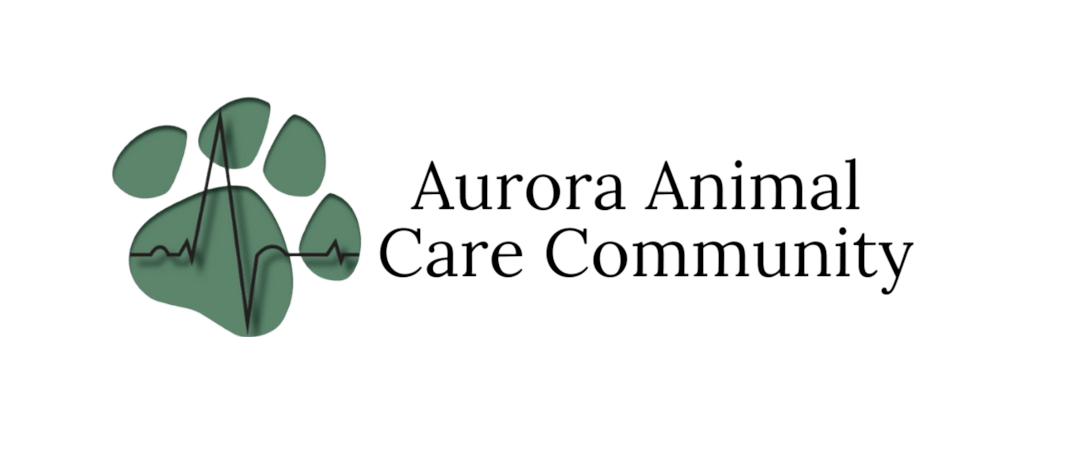By: Christine Koporc MSc and Jennifer Kartley DVM
Osteoarthritis is a degenerative process of the joints impacting dogs and cats as they age. It's irreversible and progresses over time, so if it's not managed properly, it can negatively impact your pet in several ways and can cause their quality of life to decline rapidly.
Early detection is key in managing both canine and feline osteoarthritis since our pets can be great pretenders, initially redistributing weight off painful joints and not showing major signs of discomfort or pain until the disease has already progressed. Eventually, the pain caused by osteoarthritis cannot be hidden, and changes in movement can be easily spotted by most owners.
Because osteoarthritis can be so painful and debilitating for our pets, working with your veterinarian is key to early identification and customizing a treatment plan to minimize pain and maximize their well-being.
What Is Osteoarthritis in Dogs and Cats?
Osteoarthritis (OA), also known as arthritis or degenerative joint disease, is a condition most common in movable joints. It can be caused by several factors, including breed predispositions, congenital abnormalities, previous injury, age, and obesity. In both dogs and cats, osteoarthritis is the most common joint disease, making it a leading cause of mobility issues in older pets.
As this irreversible disease progresses, cartilage degrades in a joint and the bones start to remodel, producing osteophytes, commonly known as bone spurs. Osteophytes are abnormal bony outgrowths that form in response to the loss of cartilage. Their goal is to stabilize the now compromised joint and provide stability. Unfortunately, they actually create restrictions and, in return, cause inflammation, pain, and loss of function. Alas, this compounding disease process continues to escalate, decreasing overall quality of life for your pet.
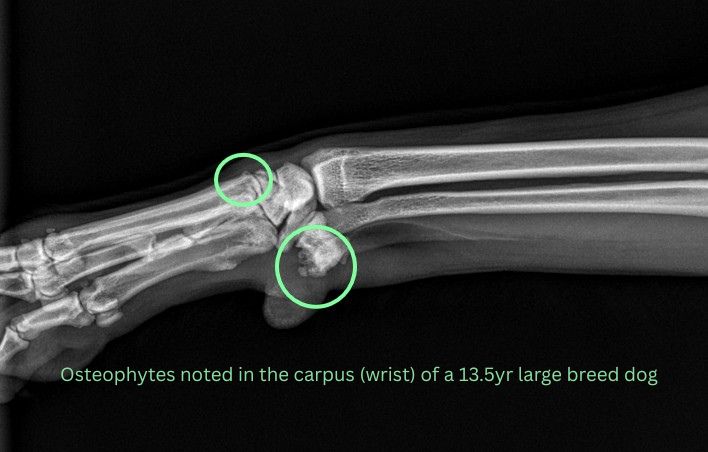
Signs & Symptoms of Arthritis in Dogs & Cats
Joints subject to movement or under a lot of stress tend to be those that show arthritis earlier. Dogs and cats do not speak traditional languages, so we must interpret their body language and daily activities to gauge how they are doing.
Clues such as: unwillingness to play or socialize, abilities like keeping up on walks, grooming themselves, jumping up or down from perches/couches, or use of the stairs historically might be attributed to "old age" or "slowing down." However, this determination is wrong! We now appreciate that this is often avoidance of activities due to the pain and inflammation of OA. Chronic pain takes a huge toll on the quality of life an individual pet experiences. OA is irreversible, but let's learn about early detection and the many interventions available for your pet.
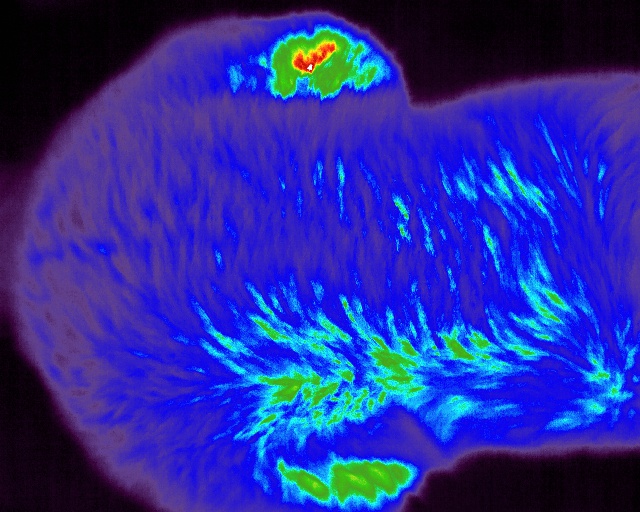 Diagnosing OA in Pets: What Your Vet Will Do
Diagnosing OA in Pets: What Your Vet Will Do
The combination of a yearly wellness exam with your veterinarian and astute evaluation of your pet at home is important when assessing the health and fitness of your pet. Keeping track of your pet's normal habits and proper owner education on the early signs and symptoms of arthritis in cats and dogs is important. If your pet is moving abnormally, it is because something is abnormal. You know your pet best – if you see something, let us know.
With OA, little changes, less than a traditional limp, are the clue and opportunity to slow disease progression and alleviate pain and discomfort. Diagnostic tools may be recommended by your veterinarian, which can include radiographs (x-ray), thermal imaging, and measurable physical exam markers like thigh circumference and range of joint movement.
Understanding the Treatment Options Available for Cats and Dogs With Osteoarthritis
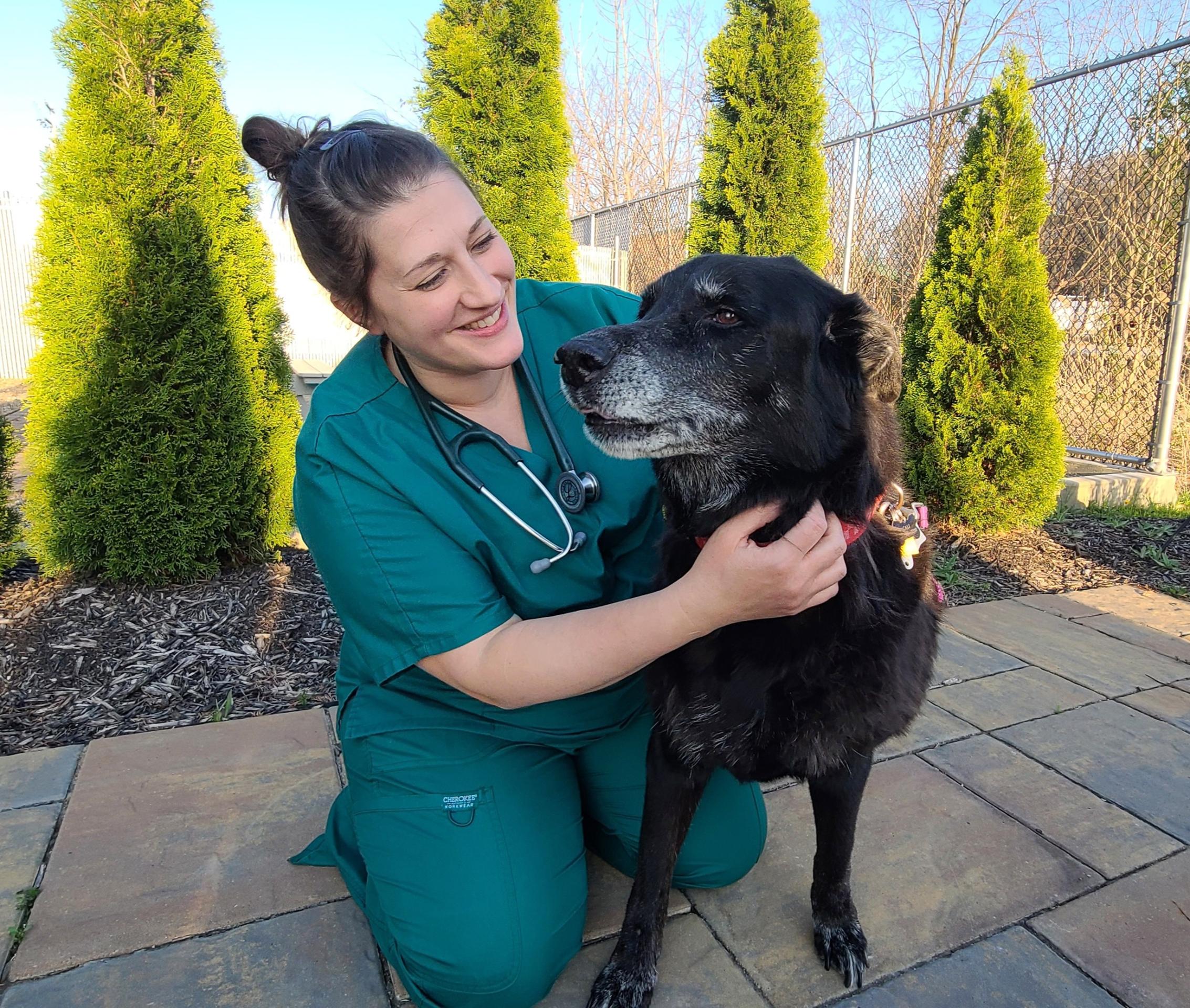
A diagnosis of osteoarthritis and localization of affected joints allows for a tailored treatment plan. Your veterinarian should provide education on your treatment options. Lifestyle modifications like putting down rugs allow your pet to move more easily on slippery floors, ramps, or steps, help them with getting up and down from the car or the couch, and special harnesses allow support while on a walk. Adhesive paw stickers can be purchased online and adhere to the paw pads, making it less likely for them to slip on the floor.
Obesity is a hurdle for many pets with osteoarthritis. Extra weight on their joints compounds the disease process into a very painful experience for your pet. Start with a food calculation from your veterinarian. Evaluation of total calories eaten versus used in daily activity can help to achieve your pet's weight loss goals. Prescription joint food options are available. These diets provide enhanced nutrition and support for the joints while, in some cases, also encouraging weight loss. At-home exercises under the guidance of your veterinarian can target problem joints to maintain and strengthen muscle mass. We have created our At Home Exercises and Sit to Stand videos for instructions on how to perform these with your pet.
Medications for OA Treatment
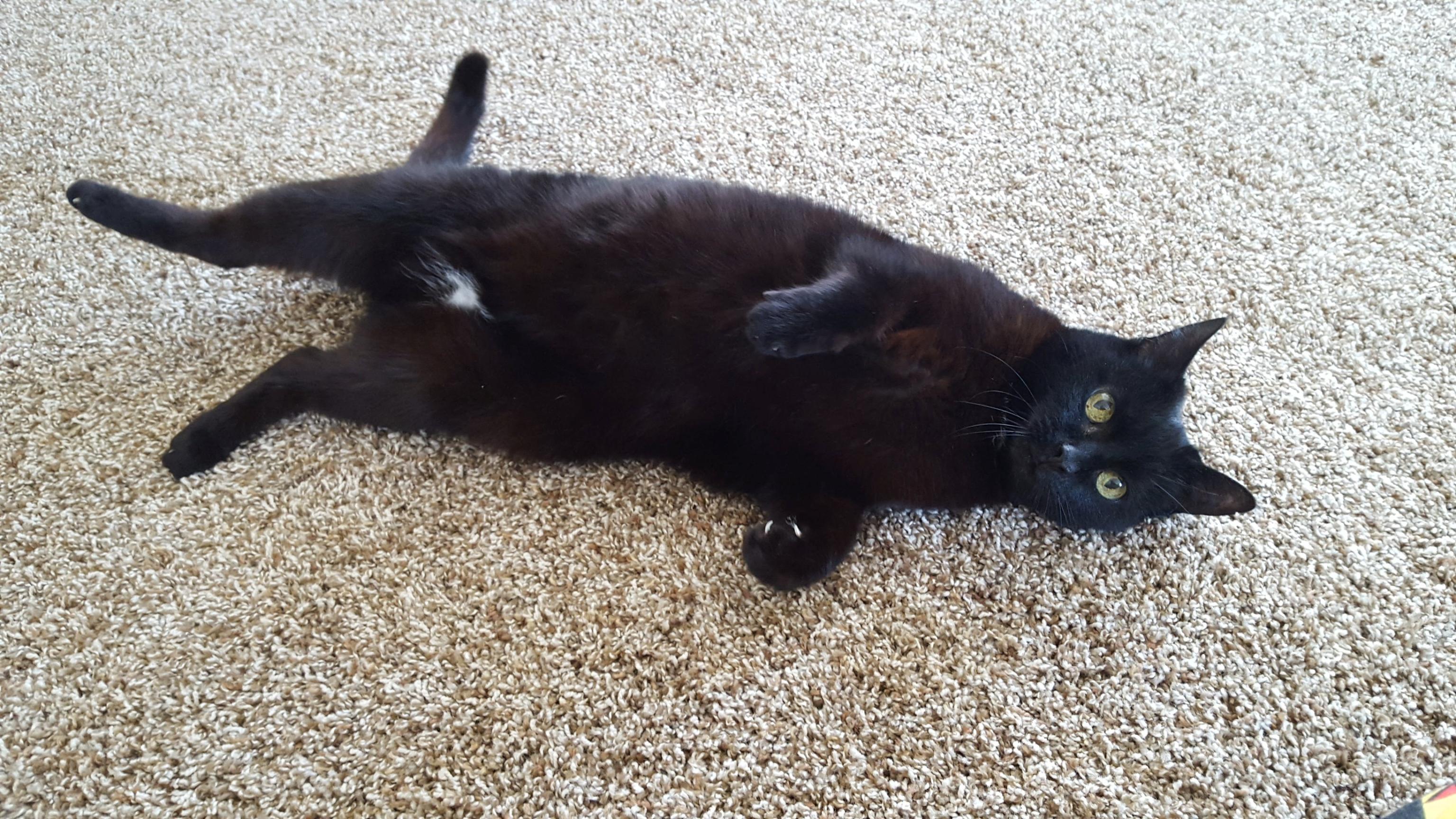
Dogs are not small humans, and cats are not small dogs! Physiologically, dogs and cats cannot safely handle all the same medications, let alone most human pain medication options.
Dog-safe NSAIDs are available while under the guidance of routine blood work, which monitors organ function. There are limited long-term oral pain medication options for cats. Joint supplements may be recommended to support function and provide needed nutrients, but they are not all created the same. Supplements are not true pain medications, but are excellent participants in a multimodal approach to treating your pet's OA pain!
New technology available for both dogs and cats is monoclonal antibody therapy. This breakthrough therapy to help manage OA pain consists of a monthly injection at your veterinarian's office. Because this therapy is minimally processed by your pet's organs, it can be given to pets who didn't have other effective options because of their health status. Keep in mind that older pets with OA frequently suffer from organ dysfunction, aging changes, and cancers. Imagine the joy of the veterinary community when given the opportunity to provide effective long-term pain relief for cats and dogs who previously had very limited options!
Alternative Therapies for OA Treatment
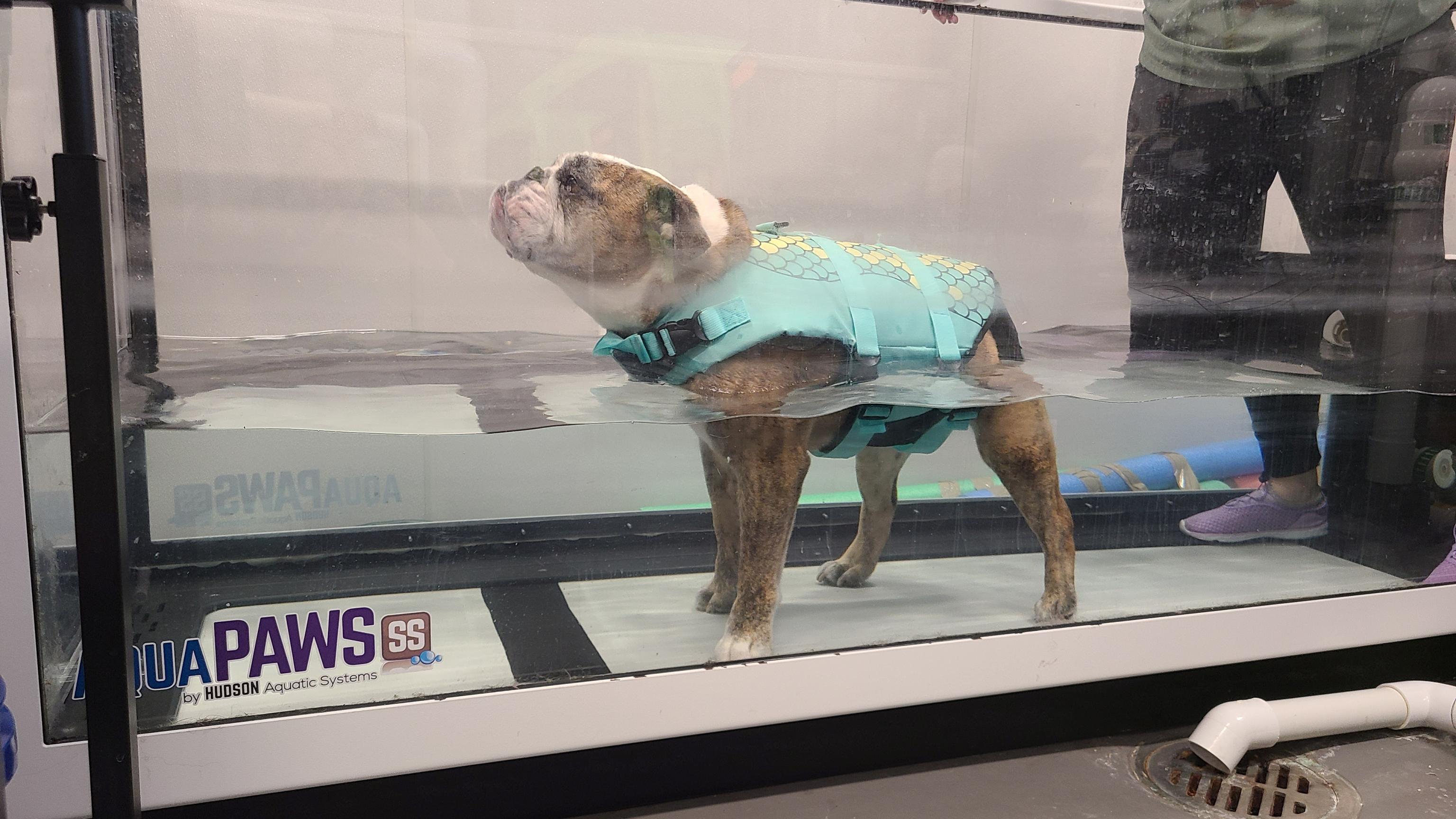
When it comes to joints, motion is lotion! Targeted physical movement can be a great addition to the multimodal treatment of OA pain. At Aurora Animal Care Community, we have two Certified Canine Rehabilitation Practitioners (CCRP) who operate out of our specialty service, Aurora K9 Fit. They are trained to provide customized exercises to help your pet. These may include ground exercises to help with joint flexion and extension, and an underwater treadmill, which increases buoyancy, providing support while exercising to strengthen muscles. They can also implement laser therapy and e-stim treatments. The multitude of options doesn't end there; our rehab practitioners can provide customized treatment plans to continue the care at home for your pet.
Daily Care & Prevention of OA
Monitoring your pet's normal activity is important when assessing the progression of osteoarthritis. If you notice gait or movement changes, make an appointment with your vet. Remember, a patient might be excited when they come in and hide their pain, so short videos taken at home can be helpful.
Early intervention can dramatically slow the progression of OA and delay the chronic pain and discomfort older pets experience. Maintenance of a healthy weight decreases the stress on healthy joints. Performing at-home exercises helps to keep your pet's muscle mass up. We have said motion is lotion, but remember, rest is rust! New recommendations suggest that starting joint supplements for your pet as a young adult can be another step to prevent the early onset of OA.
All Pets, All Sizes, Experience OA Pain
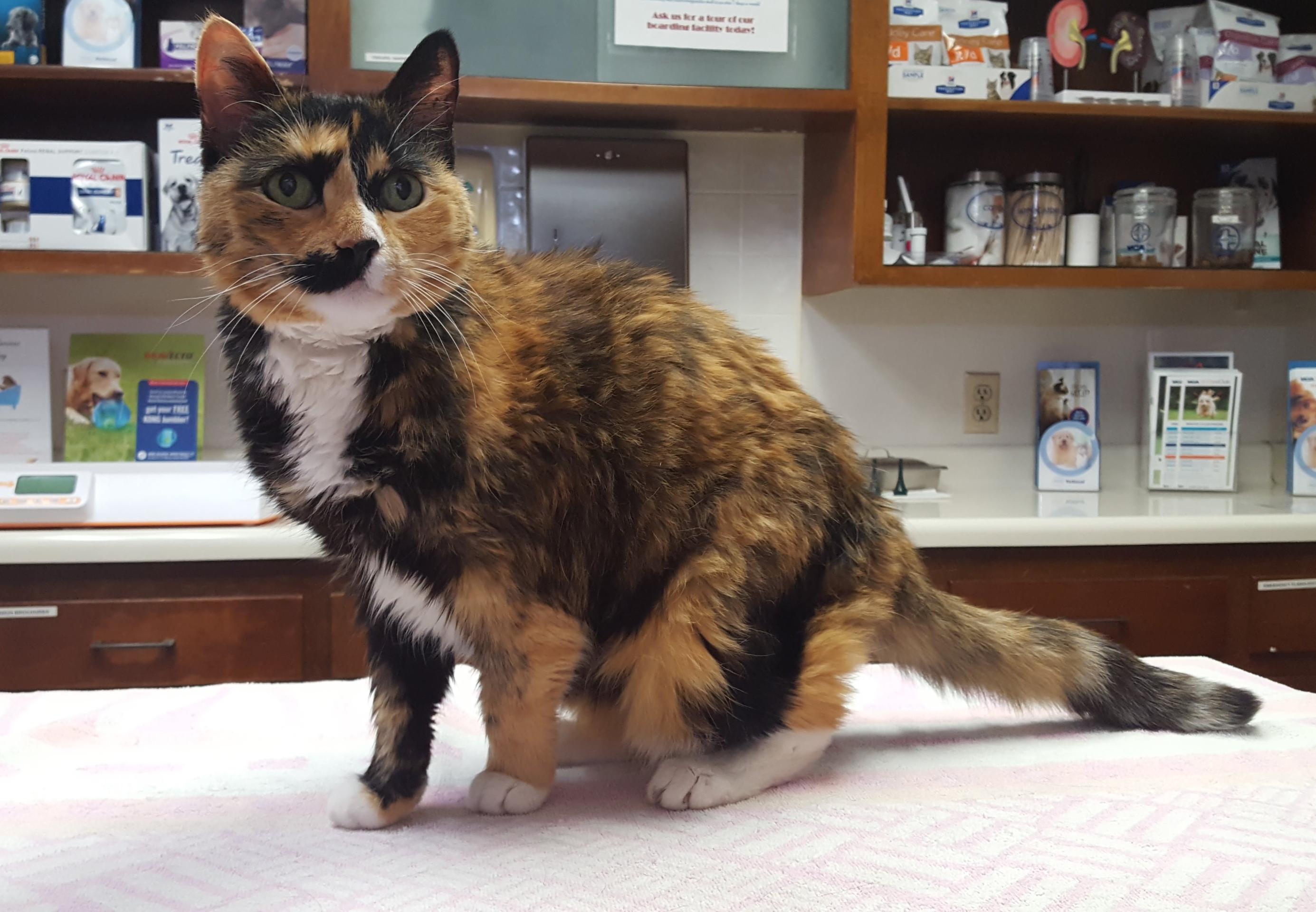
A consultation with one of our veterinarians allows the utilization and implementation of the various interventions regarding canine and feline osteoarthritis. Your pet's quality of life should be a top priority, and no matter how big or small, they can experience the pain of osteoarthritis. Chronic pain for any individual decreases their quality of life.
The bond we share with our pets revolves around movement. Being enthusiastic about you coming home, keeping up on walks, playing with their toys, their general mentation, and being your little shadow are all things that make your pet who they are. Being proactive with OA is key, as it is irreversible. The earlier you intervene, the better chance you have at slowing its progression and preventing subsequent pain. Education gives you choices as a pet owner. You are not alone; your veterinarian is here to help discuss the options with you! Schedule an appointment today to discuss OA and your pet's customized set of options.
